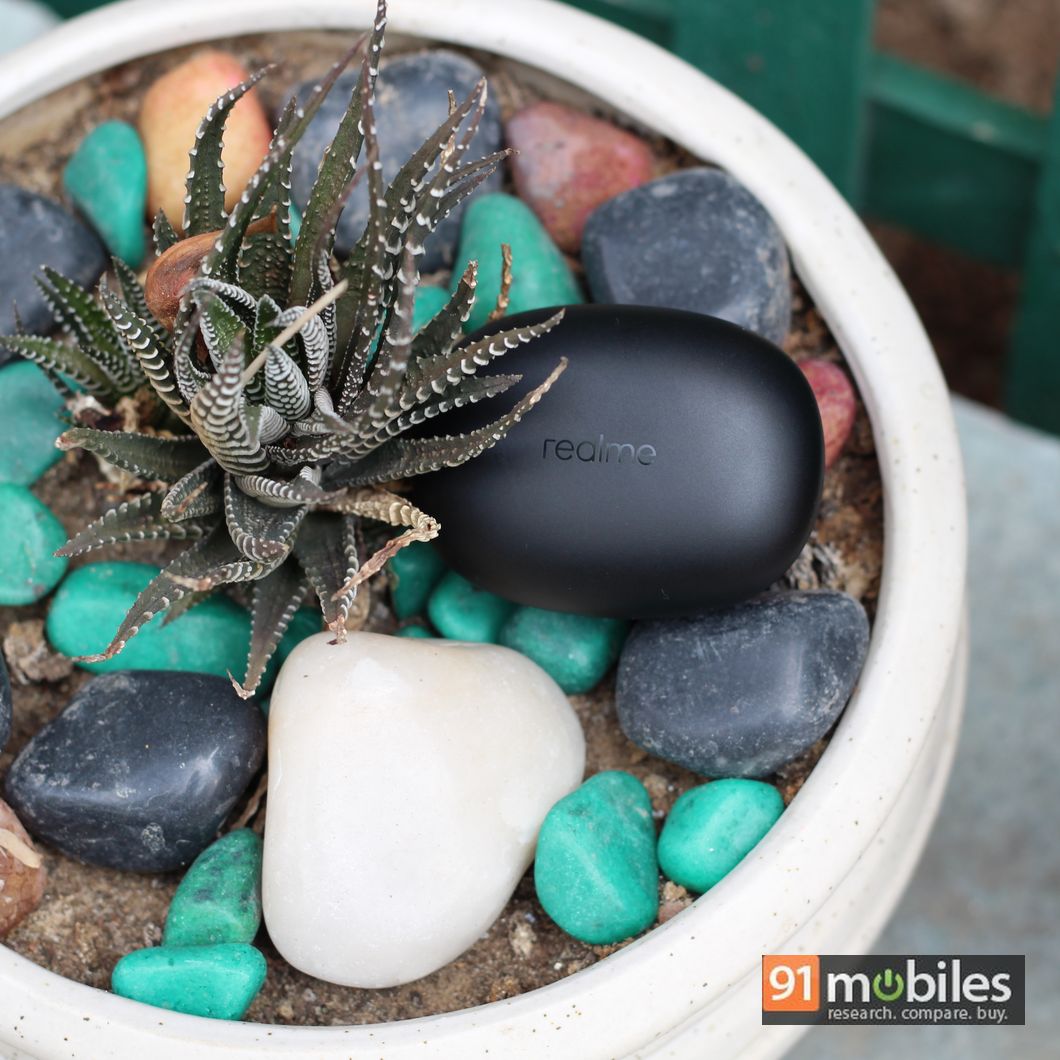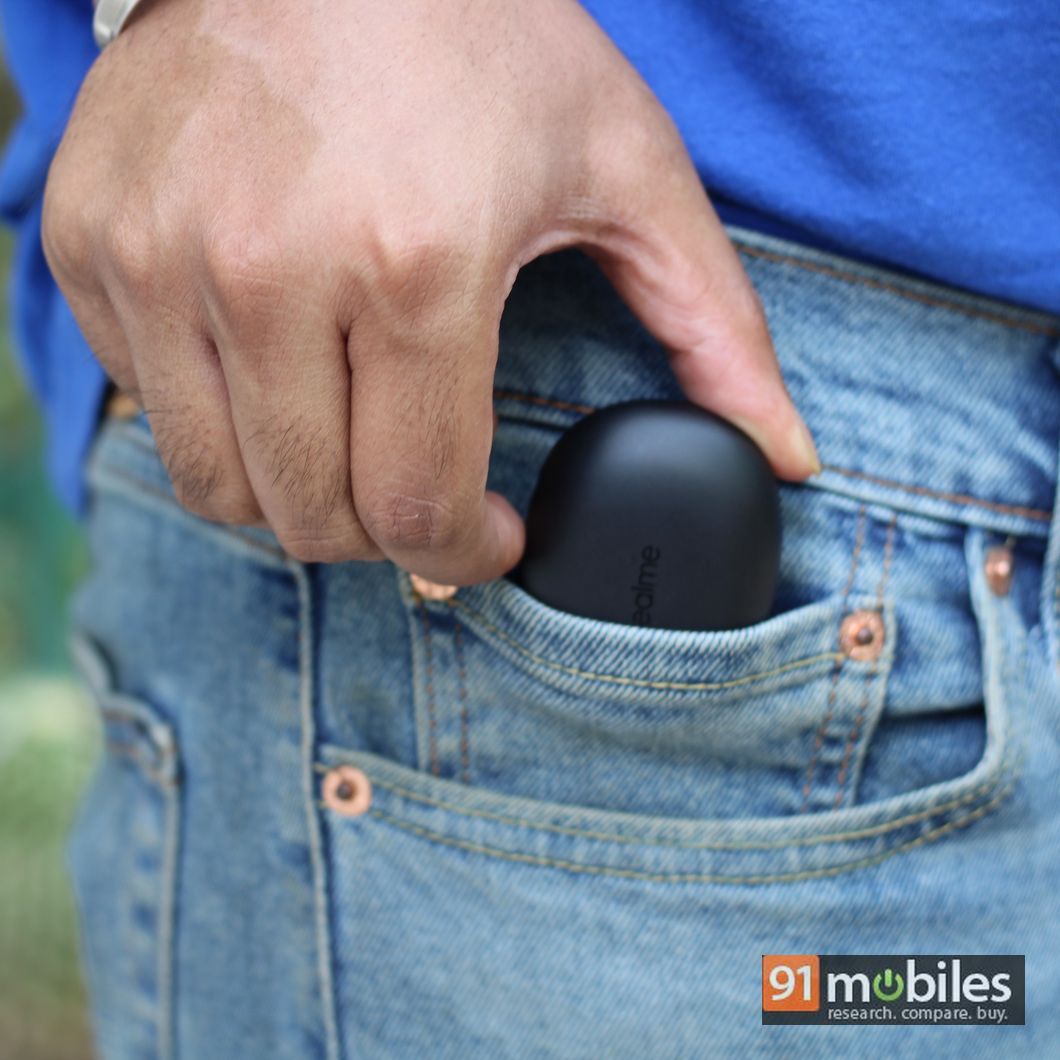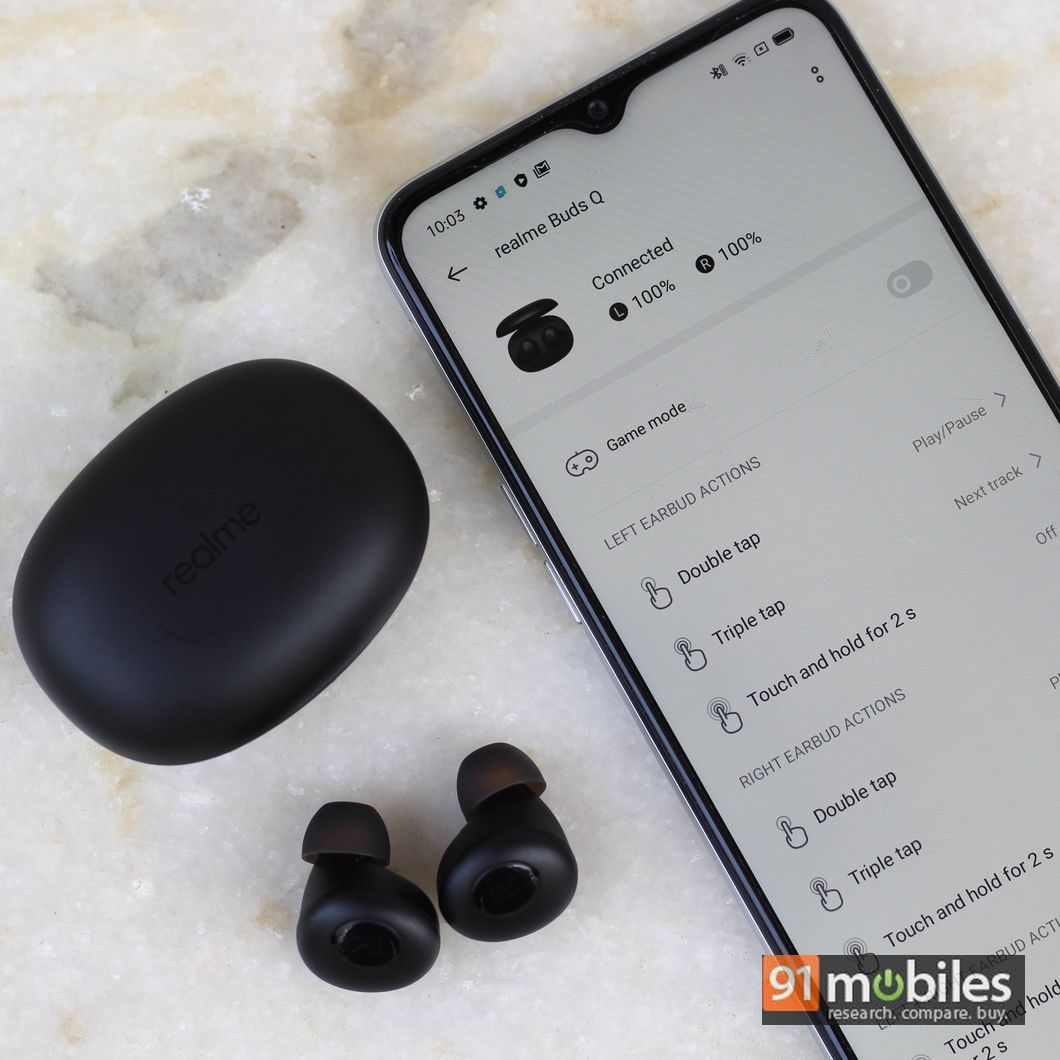The hearables market in India has been growing slowly and steadily over the past few years, but things have kicked into high gear in 2020 with Realme, Xiaomi, OPPO and other OEMs launching a slew of truly wireless earphones in a short span of time. Take Realme, for example, which has launched three TWS earbuds in a span of just six months. It began with the Realme Buds Air (review) in December, which offered premium features like wireless charging and a Type-C port at just Rs 3,999. The brand then launched the Realme Buds Air Neo which were cheaper at Rs 2,999. On Thursday, the company launched the Realme Buds Q, which come with an even lower price tag of Rs 1,999.
The Realme Buds Q are the the company’s most affordable TWS earbuds yet, and they come with a brand new design language. Unlike the Realme Buds Air and Buds Air Neo, the Buds Q offer a pod-shaped design that fits inside the ears. The earbuds tout features like 20-hour music playback, low latency gaming mode, touch controls, Bluetooth 5.0, and IPX4 water resistance. For an ultra-affordable pair of TWS earbuds, Realme is also promising good bass-forward sound quality.

Verdict
Realme is looking to flood the affordable truly wireless earbuds market with its products, and so far the company has done a fairly decent job of doing that. The Realme Buds Q are affordable, bass-heavy earbuds with a lightweight design and solid battery life, which should appeal to a lot of people in India. However, the build quality and connectivity issues could leave you wanting more.
Design and comfort
As mentioned earlier, Realme Buds Q look very different from the Realme Buds Air and Buds Air Neo. For starters, these are pod-shaped earbuds that fit inside your ears, similar to the Samsung Galaxy Buds. The earbuds don’t come with AirPods-like stems, which means the microphone will be farther away from your mouth. I will talk about the call quality experience in a little while. The earbuds are small and extremely lightweight to the point that they feel toy-like. I am told each earbud is roughly 3.6 grams, so you barely feel them in your ears. This is the first pair of TWS earbuds from the brand to offer silicone ear-tips, which is the only thing that you do feel in your ears. While the Buds Q do not offer noise cancellation, the ear tips provide a decent seal to block out some external sounds.

The plastic earbuds have a largely smooth matte finish, except for a part of the surface which is glossy. This part is touch-sensitive, allowing you to perform gestures like double tapping to play and pause music, and triple tapping to go to the next song. You can press and hold one side of the earbuds to end a call, and you can press and hold both earbuds to activate or deactivate gaming mode. This is a low latency mode, which comes in particularly handy while playing games where you want to reduce the delay between gameplay and audio as much as possible.
The Realme Buds Q have been designed by Paris-born Jose Levy who was inspired by the soft, round pebbles on the beaches of Normandy, France. And you can see the inspiration, especially with regards to the charging case, which has a Cobble design as the company calls it. The case is soft, smooth and round as you would expect a pebble to be. Even the earbuds themselves are rounded to offer a smooth feel in your hand. The plastic charging case has a matte finish, making it quite slippery to hold. In fact, I found it quite difficult at time to open the lid with one hand as the case would slip through my fingers. I would have appreciated a bigger slit to make it easier to open the lid.

Opening the lid can make the case feel rather flimsy and closing it won’t offer the kind of satisfying click sound you’d get from say the AirPods or even the Realme Buds Air. But one can’t expect a sub-Rs 2,000 TWS earbuds to offer great build quality. What I did like was the way the earbuds sit inside the case and don’t drop out easily, even if you hold the case upside down. The charging case and earbuds come in black and white colour options. I received the black colour unit and noticed some minor scratches on the surface of the case after a few days.
As for comfort, I found no issues having the lightweight earbuds in my ears for hours at a stretch. They barely weigh down in your ears and the silicone tips are comfortable as well. With IPX4 rating, the earbuds can survive through some sweat as well, which means you can use them while working out. While running, the earbuds stayed inside my ears and never fell out. The charging case is smaller in width compared to the Galaxy Buds case and could easily fit inside the small pocket of my jeans.
Sound quality and connectivity
The Realme Buds Q are equipped with a 10mm Dynamic Bass Boost driver, which is enough to tell you that the earbuds will deliver a bass-forward sound. They also support Bluetooth 5.0 with a range of 10 meters. The earbuds support AAC HD audio codec and Dynamic Bass Boost solution. I tried the earbuds with my iPhone XR, OPPO Find X2 Pro and Realme Narzo 10 to see how the earbuds work with various smartphones. While you can pair the earbuds with the iPhone, you won’t be able to update the Buds Q as the Realme Link app is yet to be supported on iOS.

I played some tunes through Spotify and Apple Music, looking at different genres to see which ones work the best with the Buds Q. The earbuds tend to amplify the bass at the cost of clarity. Vocals get suppressed in bass-heavy songs and there’s a distinct U-shaped sound signature where the bass and treble are emphasised. You can use an equaliser to tune the buds to your liking, but I would have loved to see a more balanced sound out of the box.
The Realme Buds Q work well with genres like Hip-Hop where you want trip on those thumping bass sounds. So, songs like Kohinoor by Divine and Forever by Chris Brown sound energetic and will surely pump you up. The earphones also work well enough in acoustic songs like John Mayer’s I Guess I Just Feel Like where you can hear the guitar strumming clearly. However, Mayer’s vocals lack depth and don’t sound as crystal clear as I would have liked.

The Realme Buds Q are definitely not meant for Rock songs or songs that involve a lot of instruments. I checked out Belly Belly Nice by Dave Matthews Band and it sounded quite bad. This is a song that requires a wide soundstage for all the interments to be distinctly heard. The Buds Q offer a very narrow soundstage, which tends to make instruments sound crowded and stuffy. The bass sounds get amplified while instruments like the saxophone can get pitchy, leaving the guitar sounds and Dave Matthews’ vocals lost in the crowd.
Overall, the Realme Buds Q’s sound quality will please those who love a lot of bass, which is a sizeable section in India. You can’t expect a balanced sound quality from ultra affordable truly wireless earbuds and I don’t expect to see audiophiles shopping in the sub-Rs 2,000 segment anyways. For their price, the Realme Buds Q are decent-sounding TWS earbuds for bassheads out there.
With Bluetooth 5.0 connectivity the Realme Buds Q offer a reliable connection most of the times. However, I did notice drops in connectivity while running outdoors with the phone in my pocket. This happened not only when the earbuds were paired to the iPhone, but also when they were paired with the OPPO Find X2 Pro.

The Realme Buds Q are pretty average when it comes to call quality. With the microphone so far away from your mouth, the caller on the other end of the line will find it difficult to hear you if you’re say walking down a busy road or if you’re in a noisy environment. The stem design on the Realme Buds Air and Buds Air Neo are better suited for taking calls. Realme said that the earbuds automatically connect with the paired phone as soon as you open the lid, but I did not find this to be true. The buds only connect to the device after you remove them from the case and it takes a few seconds to pair up, so the process is not as seamless and quick as the company claims.
I mentioned earlier that the Realme Buds Q come with a low latency gaming mode. By pressing and holding the surface of both the earbuds for a few second, you can enable gaming mode by hearing the sound of a car engine. This is supposed to make your gameplay experience better by reducing the audio latency, which can be quite helpful in games like PUBG. I was generally satisfied with the gaming mode and was able to play a few sessions without being killed too easily.
Battery life
For extremely lightweight earbuds and charging case, the Realme Buds Q offer surprisingly solid battery life. Realme claims each earbud delivers 4.5 hours of battery life on a single charge and can deliver up to 20 hours with the help of the charging case, which is even better than what the Realme Buds Air deliver. I couldn’t accurately figure out whether the Buds Q deliver 20 hours as promised, but I could feel it to be true as I didn’t find myself reaching for the charger after a week with roughly 2-3 hours of listening time each day. The Realme Buds Q charging case comes with a micro-USB port instead of a Type-C port, which is kind of a bummer.

Final verdict
The Realme Buds Q are among the most affordable truly wireless earbuds you can find in the market, and this itself is enough to make it appealing to a lot of buyers out there. The company is offering some popular features with the Buds Q such as a lightweight, pocketable build, solid battery life, and in-ear design. Most importantly, the bass-heavy sound signature is sure to attract a large number of buyers. But the Realme Buds Q are not perfect.
The Realme Buds Q are far from being the best TWS earbuds for music listening. Without a balanced sound output, the earbuds work well only for specific genres of music. I also found the Bluetooth connectivity spotty at times, especially while working out. I’m not sure if this was a problem just with my review unit, and it’s possible it can be fixed via a software update.
But when it comes to sub-Rs 2,000 TWS earbuds, these issues are to be expected and I can’t criticise the Realme Buds Q too harshly. The earbuds go up against the likes of the Redmi Earbuds S, which are more affordable at Rs 1,799. We haven’t reviewed the Redmi Earbuds S yet, so I can’t say how it compares to the Realme Buds Q. The good thing about Realme’s strategy in the sub-Rs 5,000 segment is that you have a few options at hand. So if you’re not comfortable with the in-ear design and silicone ear-tips, you can opt for the Realme Buds Air or Buds Air Neo instead.
Editor’s rating: 3.5 / 5
Pros
- Affordable price
- Lightweight build
- Solid battery life
Cons
- Lacks balanced sound quality
- Not ideal for calls
- Iffy Bluetooth connectivity













